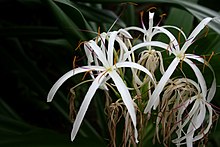bio.wikisort.org - Plant
Crinum asiaticum, commonly known as poison bulb, giant crinum lily, grand crinum lily, or spider lily,[2] is a plant species widely planted in many warmer regions as an ornamental. It is a bulb-forming perennial producing an umbel of large, showy flowers that are prized by gardeners. However, all parts of the plant are poisonous if ingested. Some reports indicate exposure to the sap may cause skin irritation.[2][3]
| Crinum asiaticum | |
|---|---|
 | |
 | |
| Scientific classification | |
| Kingdom: | Plantae |
| Clade: | Tracheophytes |
| Clade: | Angiosperms |
| Clade: | Monocots |
| Order: | Asparagales |
| Family: | Amaryllidaceae |
| Subfamily: | Amaryllidoideae |
| Genus: | Crinum |
| Species: | C. asiaticum |
| Binomial name | |
| Crinum asiaticum | |
| Synonyms[1] | |
| |
C. asiaticum is native to Indian Ocean islands, East Asia, tropical Asia, Australia and Pacific islands. It is regarded as naturalized in Mexico, the West Indies, Florida, Louisiana, numerous Pacific islands, Madagascar and the Chagos Archipelago.[1]
Description
This section needs additional citations for verification. (January 2022) |
C. asiaticum is a perennial herb that typically grows up to 1.2 m (3.9 ft) tall.[4] It has a leaf base. Its pseudobulb is spherical. The upper part of the bulb is cylindrical. The base is laterally branched, with a diameter of about 6–15 cm. Its leaves are lanceolate, margin undulate, apically acuminate. They feature 1 sharp point and are dark green, growing up to 1 m long. Their width is 7–12 cm or wider and they number 20-30. The inflorescence is an umbel with 10-24 flowers, six petaloid tepals, and aromatic. The flower stem is erect, as long as the leaf, and solid. The spathe is lanceolate, membranous, and 6–10 cm. The bractlet liner is 3–7 cm. Its perianth tube is slender and straight, green white, 7–10 cm, diameter 1.5–2 mm. The corolla is spider-like shaped, white, linear, revolute, attenuate, 4.5–9 cm long, and 6–9 mm wide. The corolla is 6-lobed. The pedicel is ca 0.5-2.5 cm long. It has 6 reddish stamens. The filaments are 4–5 cm long. The anthers are liner, attenuate, ca. 1.5 cm long or more. The ovary is fusiform, and up to 2 cm long. The fruit is an oblate capsule, green, and 3–5 cm in diameter. The seeds are large, and the exotesta is spongy.
Toxicity
The entire plant is toxic, especially the bulb.[4] It contains a variety of alkaloids such as lycorine[5] and tazettine. When eaten, it can cause vomiting, abdominal pain, severe diarrhea, constipation, irregular breathing, rapid pulse, fever, etc.; sufficient misuse can cause nervous system paralysis and death.[6]
References
- "Crinum asiaticum". World Checklist of Selected Plant Families (WCSP). Royal Botanic Gardens, Kew. Retrieved 6 July 2017.
- "PlantFiles: Poison Bulb, Giant Crinum Lily, Grand Crinum Lily, Spider Lily Crinum asiaticum". Dave's Garden. Retrieved 18 April 2014.
- "Crinum asiaticum". floridata.com. Retrieved 18 April 2014.
- "Crinum asiaticum - L." Plants for a Future. Archived from the original on 2010-09-24. Retrieved 16 January 2022.
- "Protection of human erythrocyte using Crinum asiaticum extract and lycorine from oxidative damage induced by 2-amidinopropane". Pub Med. 18 April 2011. Archived from the original on 2022-01-16. Retrieved 16 January 2022.
- "Crinum Lily Poisonous or Toxic: Are Crinum Lilies Safe To Grow?". Plant Care Today. Archived from the original on 2022-01-16. Retrieved 16 January 2022.
На других языках
- [en] Crinum asiaticum
[es] Crinum asiaticum
Crinum asiaticum L. es una especie perenne y bulbosa perteneciente a la familia Amaryllidaceae. Como otras especies del género Crinum, presenta vistosas flores parecidas a las de los lirios (Lilium) y se la cultiva en jardines por esa razón. Como el epíteto específico lo indica, es originaria de regiones tropicales de Asia.[ru] Кринум азиатский
Кри́нум азиа́тский (лат. Crinum asiaticum) — вид луковичных растений рода Кринум (Crinum) семейства Амариллисовые (Amaryllidaceae).Другой контент может иметь иную лицензию. Перед использованием материалов сайта WikiSort.org внимательно изучите правила лицензирования конкретных элементов наполнения сайта.
WikiSort.org - проект по пересортировке и дополнению контента Википедии